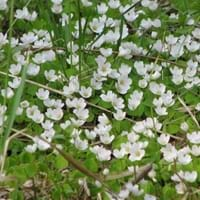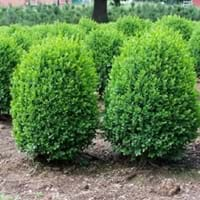Life Span
Perennial
Perennial
Type
Perennial
Broadleaf Evergreen
Origin
World, Pandemic, North America, Europe, United Kingdom, Asia
Europe, Southern Europe, Turkey, Northern Africa
Types
Not available
Elegantissima boxwood, Latifolia Maculata boxwood
Number of Varieties
Not Available
Habitat
Shaded sites, Woodlands
Sandy areas, Temperate Regions
USDA Hardiness Zone
3-8
5-8
AHS Heat Zone
8-1
Not Available
Sunset Zone
A3, 1a, 1b, 2a, 2b, 3a, 3b, 4, 5, 6, 7, 8, 9, 10, 14, 15, 16, 17, 18, 19, 20, 21, 22, 23, 24
21,22
Habit
Mat-forming
Oval or Rounded
Flower Color
White, Light Pink
Yellow green
Flower Color Modifier
Bicolor
Bicolor
Fruit Color
Not Available
Not Available
Leaf Color in Spring
Light Green
Green
Leaf Color in Summer
Light Green
Dark Green
Leaf Color in Fall
Light Green
Dark Green
Leaf Color in Winter
Light Green
Olive, Dark Green, Bronze
Leaf Shape
Heart-shaped
Elliptic
Plant Season
Spring, Summer, Fall
Spring, Summer, Fall, Winter
Sunlight
Partial Sun, Partial shade, Full Shade
Full Sun, Partial Sun
Type of Soil
Clay, Loam, Sand
Loam, Sandy
The pH of Soil
Neutral
Acidic, Neutral
Soil Drainage
Average
Sandy
Bloom Time
Spring
Late Spring
Tolerances
Shade areas
Not Available
Where to Plant?
Ground
Ground
How to Plant?
Divison, Seedlings
Leaf Cutting, Stem Cutting, stem tip cuttings
Plant Maintenance
Low
Medium
Watering Requirements
Water in the early morning hours
Do not water frequently
In Summer
Lots of watering
Lots of watering
In Spring
Moderate
Moderate
In Winter
Average Water
Average Water
Soil pH
Neutral
Acidic, Neutral
Soil Type
Clay, Loam, Sand
Loam, Sand
Soil Drainage Capacity
Average
Well drained
Sun Exposure
Partial Sun, Partial shade, Full Shade
Full Sun, Partial Sun
Pruning
Remove damaged leaves, Remove dead branches, Remove dead flowers, Remove dead leaves
A hard prune may be necessary if the plant becomes woody, Cut away fading foliage, Prune if you want to improve plant shape, Remove damaged leaves, Remove dead branches, Remove dead leaves
Fertilizers
All-Purpose Liquid Fertilizer
Compost, fertilize in growing season
Pests and Diseases
Aphids, Root rot, Whiteflies
Mildew, Mites, Red blotch
Plant Tolerance
Shade areas
Salt and Soil Compaction, Shallow soil
Flowers
Yes
Insignificant
Flower Petal Number
Single
Single
Foliage Texture
Medium
Fine
Foliage Sheen
Matte
Glossy
Attracts
Insects
Caterpillar, Early/Late Blight, Mites, Spider Mites
Allergy
Asthma, Depression
Eye irritation, Skin irritation
Aesthetic Uses
Not Used For Aesthetic Purpose
Not Used For Aesthetic Purpose
Beauty Benefits
Good for skin, Not Available
Blackheads, Good Cleanser, Makes Hair Silkier
Environmental Uses
Air purification
Air purification, Erosion control, Provides ground cover
Medicinal Uses
Digestive, Eye Problems, Vitamin A, Vitamin C
Dermatitis, epilepsy, Treating fever
Part of Plant Used
Flowers, Leaves
Bark, Leaves
Other Uses
Cleanser
Decoration Purposes, Showy Purposes, Used to make chess pieces
Used As Indoor Plant
No
No
Used As Outdoor Plant
Yes
Yes
Garden Design
Container, Mixed Border, Wildflower
Bonsai, Edging, Espalier, Foundation, Hedges, Rock Garden, Wall
Botanical Name
OXALIS acetosella
Buxus sempervirens
Common Name
wood sorrel, common wood sorrel
English boxwood
In Hindi
Wood Sorrel
European boxwood
In German
Sauerklee
Gewöhnlicher Buchsbaum
In French
bois Sorrel
Buis commun
In Spanish
alazán de madera
boj común
In Greek
ξύλο Sorrel
European boxwood
In Portuguese
Sorrel de madeira
Buxo
In Polish
Drewno szczaw
Bukszpan wieczniezielony
In Latin
Rumex ligno
European boxwood
Phylum
Magnoliophyta
Tracheophyta
Class
Magnoliopsida
Magnoliopsida
Family
Oxalidaceae
Buxaceae
Clade
Angiosperms, Eudicots, Rosids
Angiosperms, Eudicots
Tribe
Not Available
Not Available
Subfamily
Not Available
Not Available
Importance of Wood Sorrel and English Boxwood
Want to have the most appropriate plant for your garden? You might want to know the importance of Wood Sorrel and English Boxwood. Basically, these two plants vary in many aspects. Compare Wood Sorrel and English Boxwood as they differ in many characteristics such as their life, care, benefits, facts, etc. Every gardener must at least have the slightest clue about the plants he wants to plant in his garden. Compare their benefits, which differ in many ways like facts and uses. The medicinal use of Wood Sorrel is Digestive, Eye Problems, Vitamin A and Vitamin C whereas of English Boxwood is Dermatitis, epilepsy and Treating fever. Wood Sorrel has beauty benefits as follows: Good for skin and Not Available while English Boxwood has beauty benefits as follows: Good for skin and Not Available.
Compare Facts of Wood Sorrel vs English Boxwood
How to choose the best garden plant for your garden depending upon its facts? Here garden plant comparison will help you to solve this query. Compare the facts of Wood Sorrel vs English Boxwood and know which one to choose. As garden plants have benefits and other uses, allergy is also a major drawback of plants for some people. Allergic reactions of Wood Sorrel are Asthma and Depression whereas of English Boxwood have Eye irritation and Skin irritation respectively. Having a fruit bearing plant in your garden can be a plus point of your garden. Wood Sorrel has no showy fruits and English Boxwood has no showy fruits. Also Wood Sorrel is flowering and English Boxwood is not flowering . You can compare Wood Sorrel and English Boxwood facts and facts of other plants too.





